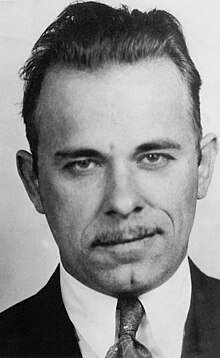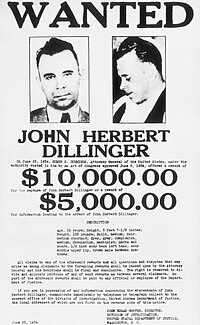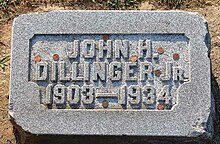John Dillinger
John Herbert Dillinger (born June 22, 1903 in Indianapolis , Indiana , † July 22, 1934 in Chicago , Illinois ) was an American gangster who specialized in bank robbery with his gang .
The FBI put a bounty of US $ 10,000 on him (around US $ 190,000 in today's purchasing power ) and declared him the first person to be "Public Enemy No. 1". Dillinger was shot dead by several FBI agents on July 22, 1934 while leaving a cinema after he had been betrayed by his friend Anna Sage , the "woman in red".
Life
Dillinger was born on June 22, 1903 in the middle-class Oak Hill neighborhood of Indianapolis, where he also grew up. His father John Wilson was a trader; his mother died when Dillinger was three years old. He was a grandson of Mathias Dillinger (* 1831 † 1912), born in 1831 in the Prussian town of Gisingen (near Dillingen / Saar , now part of the municipality of Wallerfangen in the Saarlouis district ), who emigrated from Germany to the USA in 1854.
After Dillinger finished school, he worked in a machine factory . Since his work was under-demanding, he wandered around in the evenings, which worried his father and made him move to Mooresville . But here, too, Dillinger did not stay out of problems. After falling into conflict with the law over a car theft, he joined the US Navy in 1923 . However, he deserted and returned to Mooresville, where he married and wanted to settle. However, he was charged with stealing 41 chickens and only with the help of his father could a lawsuit be avoided. John started playing baseball where he met Ed Singleton.
Because of his money problems, he tried to rob a dealer with Singleton. The project failed - apparently because his partner had not waited with a getaway car as agreed. Dillinger was arrested and, after his father persuaded him to confess, sentenced to 10 to 20 years in prison . Singleton pleaded innocent and was sentenced to two to four years. In 1933 Dillinger was released after several attempts to escape. One of his first acts after his release was a robbery on a bank in Bluffton , Ohio . On 22 September 1933, Dillinger and his gang were caught and to imprisonment in the state prison in Lima , Ohio, convicted.
Some of his gang were able to break out of the prison with the help of rifles that had been smuggled into the cells, killing two guards. On October 12, 1933, the escaped prisoners returned to free Dillinger, another guard was killed in the firefight. The FBI was called in to investigate the case. The perpetrators were quickly identified using the fingerprints . With his gang, Dillinger robbed several banks and two police arsenals, stealing machine guns , ammunition and bulletproof vests . During this time he met Evelyn Frechette . On December 14, 1933, John Hamilton, a member of Dillinger's gang, shot dead a police officer in Chicago . The robbers' next big target was the National Bank in Chicago, where a police officer was killed in the attack. The gang members fled to Florida and then to Tucson , Arizona , where they were arrested.
Dillinger was able to free himself from prison again on March 3, 1934. He later claimed that the guards with a wood and shoe polish -made dummy a gun to have threatened. He fled to Chicago in the sheriff's car . Since he had passed the state border in the car , this case became a matter for the FBI.
In Chicago, Dillinger and the rest of his gang raided other banks. The police eventually caught him in an apartment where he was shot in an exchange of fire but managed to escape. Until his wound was healed, he hid with his father in Mooresville.
Later, Dillinger and Homer Van Meter , a member of his gang, raided a police station in Warsaw , Indiana. Meanwhile, the FBI received a tip where Dillinger was hiding and drove there with several agents. There was an exchange of fire. However, Dillinger managed to escape again. At the same time, Lester Baby Face Nelson Gillis , a member of the Dillinger gang, shot and killed an FBI officer during a traffic stop and injured others.
death
On July 21, 1934, Anna Sage contacted the FBI trying to arrest Dillinger. Sage was a roommate of Polly Hamilton, who was on friendly terms with Dillinger. For information about Dillinger, she asked for $ 10,000 and permanent naturalization by immigration . When the FBI broke the deal, Sage revealed that she and Dillinger and Polly Hamilton were planning to visit the Biograph cinema at 2433 North Lincoln Avenue, Chicago, the next day to see the film Manhattan Melodrama with Myrna Loy , whose fan he was was to look at. In order to enable Dillinger to be identified more quickly, Sage wore an orange dress as agreed, which appeared reddish in the artificial light of the street lamps and thus led to her media nickname Lady in Red .
When Dillinger left the cinema with the two women on the evening of July 22, 1934, the FBI agents led by Melvin Purvis tried to arrest him. Dillinger recognized the situation and was fatally hit by three bullets while attempting to draw his weapon . Agents Charles Winstead , Clarence O. Hurt, and Herman E. Hollis fired a total of five shots. Sage received only $ 5,000 (about $ 100,000 in today's purchasing power) of the suspended bounty and was deported to Romania in 1936.
John Dillinger was buried in Crown Hill Cemetery , Indianapolis.
Since Dillinger's funeral, there has been repeated speculation that the person buried in Crown Hill Cemetery was not really Dillinger. This was justified with inconsistencies in the description of the person buried. In 2019 Michael Thompson, Dillinger's nephew, applied for the exhumation and examination of the remains to clarify these questions. On July 3, 2019, the Indiana State Department of Health approved Thompson's application and set the date for the planned exhumation to September 16, 2019. The Crown Hill Cemetery Administration rejected the plan, however, as they saw it as an essentially commercially motivated (the action was sponsored by the History Channel ) disruption of the peace of the dead . In view of the quarrels, the television station withdrew from the project without giving any reason, but the nephew continued the exhumation project and sued the cemetery. Several other family members of Dillinger spoke out against the plan, however, on October 5, 2019, an Indiana court re-approved the exhumation. The target date was December 31, 2019. The cemetery administration announced that it would go to court to appeal. According to the latest information from January 2020, Dillinger will not be exhumed because the nephew and niece have also moved away from this plan.
Film adaptations
- In 1945 the first film adaptation with the original title Dillinger, German title Jagd auf Dillinger by director Max Nosseck with Lawrence Tierney as John Dillinger, appeared.
- 1973 appeared Dillinger by John Milius with Warren Oates in the lead role.
- In 1991 a Dillinger film with Mark Harmon in the lead role and directed by Rupert Wrainrights was released with the title Dillinger - Public Enemy Number 1 .
- In 2009, the director Michael Mann filmed the life of John Dillinger in Public Enemies with Johnny Depp and Christian Bale in the leading roles.
Other cultural processing
- In the fifth season of the animated series The Simpsons , Dillinger appears together with other "damned" such as John Wilkes Booth , Lizzie Borden , Richard Nixon , Benedict Arnold and Blackbeard as a juror in a trial of the devil against Homer Simpson .
- Max Allan Collins : Gangster Brides 1934. Bastei Lübbe, Cologne 1990, ISBN 3-404-13036-7 . Collin's second historical crime novel, starring private detective Nate Heller, focuses on the interactions of independent Depression-era gangs such as Dillinger and Baby Face Nelson with investigative authorities, the Chicago mafia and local politics.
- "Dillinger è morto" ( Dillinger is dead ). Film by Marco Ferreri , Italy, 1968, with Michel Piccoli , Annie Girardot a . v. a.
music
- The first musician, who took the name Dillinger was the Jamaican Reggae - Deejay or reggae toaster Lester Bullock: On the advice of producer Lee Perry back he called to his first single Ensome City Skank / Boloman Skank (1972) Young Dillinger. Since 1973/1974 he has only been called Dillinger .
- The American mathcore band The Dillinger Escape Plan was named after John Dillinger.
- A song by David Olney on the 1999 album Through A Class Darkly is called Dillinger .
- An American rapper and music producer goes by the stage name Daz Dillinger .
- Dillinger Four is an American punk band .
- The British drum and bass artist Dillinja called himself Dillinger on his first releases.
- The American rapper and music producer Alexander Spit titled one of his albums Dillinger .
- The American band Social Distortion wrote their song Machine Gun Blues about the “Public enemy # 1” .
- The band Jello Biafra and the Guantanamo School of Medicine wrote a song about John Dillinger.
literature
- Bernd Winter: John H. Dillinger, 1933/34 America's public enemy No. 1. In: Our home. Bulletin of the Saarlouis district for culture and landscape. Volume 35, Issue 2, 2010, ISSN 1437-0905 , pp. 53–58, ( online ).
Web links
- John Dillinger in the Internet Movie Database (English)
- FBI Famous Cases: John Dillinger (English)
- Crimelibrary: John Dillinger (English)
- celebritymorgue.com - Pictures of Dillinger after his death (English)
Individual evidence
- ^ Elliott J. Gorn: Dillinger's wild ride. The year that made America's public enemy number one. Oxford Univ. Press, Oxford et al. 2009, ISBN 0-19-530483-7 , p. 123.
- ↑ Bernd Winter: John H. Dillinger, 1933/34 America's Public Enemy No. 1. In: Our home. Bulletin of the Saarlouis district for culture and landscape. Volume 35, Issue 2, 2010, pp. 53–58.
- ^ FBI History: Famous Cases John Dillinger
- ^ Joseph McNamara: The justice story. True tales of murder, mystery, mayhem. Bannon Multimedia Group, Champaign IL 2000, ISBN 1-58261-285-4 , p. 170.
- ^ John Dillinger in the Find a Grave database , accessed November 27, 2009.
- ↑ John Dillinger's Body to Be Exhumed. Courthouse News, July 31, 2019, accessed October 5, 2019 .
- ^ Holly V. Hays: After cemetery's opposition, John Dillinger's nephew seeks court order for access to grave. Indianapolis, August 15, 2019, accessed October 5, 2019 .
- ^ History Channel backs out but nephew still plans to dig up John Dillinger's body. National Post, September 16, 2019, accessed October 5, 2019 .
- ↑ John Dillinger: US gangster's body set to be exhumed. BBC News, October 5, 2019, accessed October 5, 2019 .
- ↑ Ryan Prior: Indiana approves plan to exhume John Dillinger's grave on New Year's Eve. CNN News, October 5, 2019, accessed October 5, 2019 .
- ^ Daniel Kreps: John Dillinger's Body Won't Be Exhumed, After All. Rolling Stone Magazine, January 9, 2020, accessed January 9, 2020 .
- ↑ Gangster Brides 1934 . Michael Drewniok, krimi-couch.de, June 2007
| personal data | |
|---|---|
| SURNAME | Dillinger, John |
| ALTERNATIVE NAMES | Dillinger, John Herbert (full name) |
| BRIEF DESCRIPTION | American bank robber, first person the FBI called "Public Enemy No. 1" |
| DATE OF BIRTH | June 22, 1903 |
| PLACE OF BIRTH | Oak Hill , Indiana |
| DATE OF DEATH | July 22, 1934 |
| Place of death | Chicago , Illinois |


